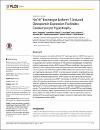Computational structural assessment of BReast CAncer type 1 susceptibility protein (BRCA1) and BRCA1-Associated Ring Domain protein 1 (BARD1) mutations on the protein-protein interface
| Author | Thirumal Kumar, D. |
| Author | Udhaya Kumar, S. |
| Author | Jain, Nikita |
| Author | Sowmya, Baviri |
| Author | Balsekar, Kamakshi |
| Author | Siva, R. |
| Author | Kamaraj, Balu |
| Author | Sidenna, Mariem |
| Author | George Priya Doss, C. |
| Author | Zayed, Hatem |
| Available date | 2022-12-15T08:24:43Z |
| Publication Date | 2022 |
| Publication Name | Advances in Protein Chemistry and Structural Biology |
| Resource | Scopus |
| Abstract | Breast cancer type 1 susceptibility protein (BRCA1) is closely related to the BRCA2 (breast cancer type 2 susceptibility protein) and BARD1 (BRCA1-associated RING domain-1) proteins. The homodimers were formed through their RING fingers; however they form more compact heterodimers preferentially, influencing BRCA1 residues 1-109 and BARD1 residues 26-119. We implemented an integrative computational pipeline to screen all the mutations in BRCA1 and identify the most significant mutations influencing the Protein-Protein Interactions (PPI) in the BRCA1-BARD1 protein complex. The amino acids involved in the PPI regions were identified from the PDBsum database with the PDB ID: 1JM7. We screened 2118 missense mutations in BRCA1 and none in BARD1 for pathogenicity and stability and analyzed the amino acid sequences for conserved residues. We identified the most significant mutations from these screenings as V11G, M18K, L22S, and T97R positioned in the PPI regions of the BRCA1-BARD1 protein complex. We further performed protein-protein docking using the ZDOCK server. The native protein-protein complex showed the highest binding score of 2118.613, and the V11G mutant protein complex showed the least binding score of 1992.949. The other three mutation protein complexes had binding scores between the native and V11G protein complexes. Finally, a molecular dynamics simulation study using GROMACS was performed to comprehend changes in the BRCA1-BARD1 complex's binding pattern due to the mutation. From the analysis, we observed the highest deviation with lowest compactness and a decrease in the intramolecular h-bonds in the BRCA1-BARD1 protein complex with the V11G mutation compared to the native complex or the complexes with other mutations. 2022 Elsevier Inc. |
| Sponsor | This work was supported by Qatar University Grant# QUST-2-CHS-2019-3. |
| Language | en |
| Publisher | Elsevier |
| Subject | BRCA1-BARD1 Molecular dynamics Pathogenicity Protein-protein interaction Stability |
| Type | Book chapter |
| Pagination | 375-397 |
| Volume Number | 130 |
Check access options
Files in this item
| Files | Size | Format | View |
|---|---|---|---|
|
There are no files associated with this item. |
|||
This item appears in the following Collection(s)
-
Biomedical Sciences [833 items ]




